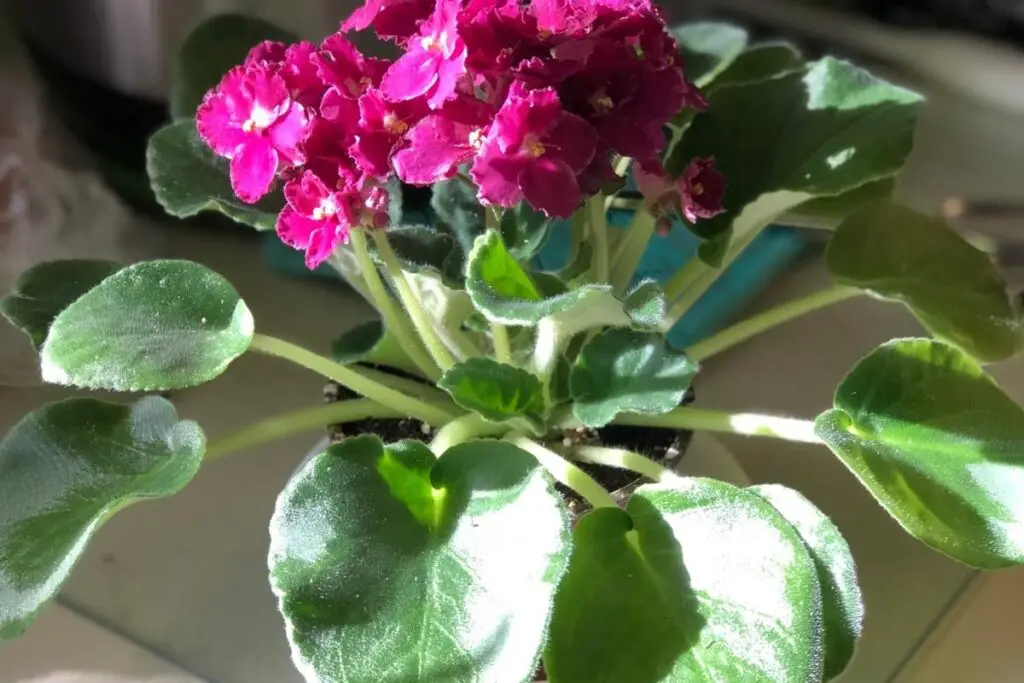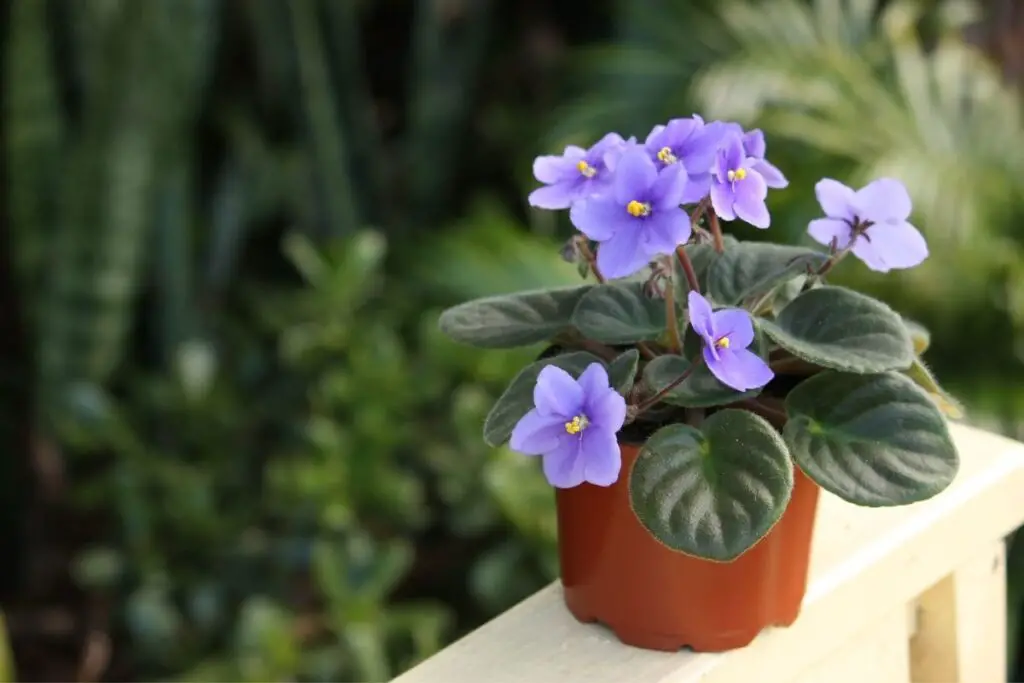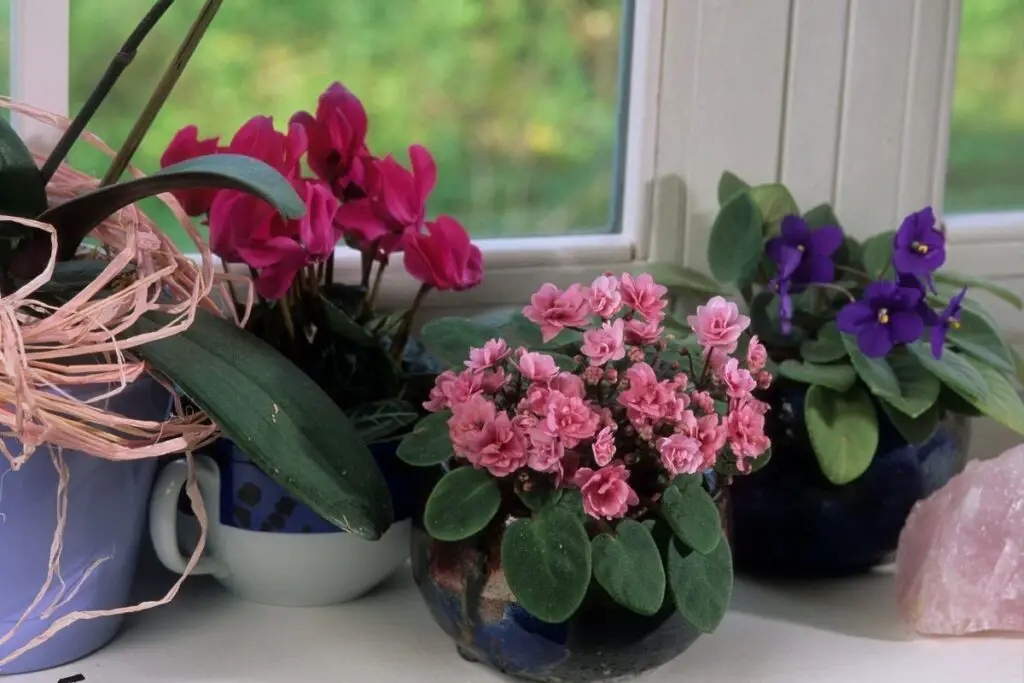African violets are popular houseplants that may bloom all year round if provided with the right growing conditions. One crucial factor that determines the growth of African violets is their location.
So, in this article, we shall discuss where do you put African violets?
African violets grow best when kept in bright, indirect light. Keeping your African violets 3-4 feet away from the south or west window would be the ideal spot to get the best blooms. A spot near the north or east window will also work; however, you must expect fewer blooms at these spots.
If you don’t have suitable windows, you can grow your African violets under fluorescent lights. In winter, keep them away from cold drafts and heat appliances.
This article will discuss all the factors that influence African violets’ location and help find the ideal spot.
Factors affecting location for African violets
The growth of healthy, beautiful, and long-lived African violets will only happen if their location is well supported by all other growth factors such as light, temperature, and humidity. Let’s now understand all the growth factors in detail.
Light Requirements

The health and overall performance of African violets depend on the light it receives. The ideal spot for African violets should support bright indirect light for their growth. You can provide light to your African violets from two sources, i.e., sunlight and artificial light.
Sunlight
Sunlight is the primary source of light for African violets. Sunlight is required to perform photosynthesis, and the absence of it will cause many problems.
If the location of the plant does not provide enough sunlight, it will have such problems:
- African violets won’t bloom, and their leaves will turn yellow.
- They will become leggy and develop elongated leaves and stems.
If the location allows too much sunlight, this too will cause problems.
- African violets will have brown spots on leaves and blooms.
- They will get sunburn as they are sensitive to direct light.
- Too much sunlight might make the leaves curl, and their variegated leaves will turn entirely green.
What would be an ideal location for African violets in terms of sunlight?
African violets will perform well if they get good indirect light. They can tolerate direct light only in the early morning or late afternoon. At other times, you should shield them from direct sunlight.
You can place your African violets on a window that will provide indirect light throughout the day. You can add a curtain to filter out direct light.
You can get a light meter for African violets, which should be around 10,000 to 12,000 lux to measure light intensity.
You can also measure this light value by simply putting your hand above your plant when it receives the brightest light. If you find the shadow of your hand over the plant, it means it is receiving adequate light.
During winters, the location should provide them with more sunlight.
You should rotate your potted African violets periodically so that they can receive an equal amount of sunlight on all sides. Rotate your African violets once a week or every time you water them.
If you do not rotate them, they can bend towards the light and grow on the side closest to the window.
Artificial light
Artificial or grow lights are another way of providing light to African violets. If there are no suitable windows in your home for African violets, you should go for indoor fluorescent lights.
You have to select a light that emits light in both blue and red spectrums. Blue light is needed for photosynthesis to occur, and red light is needed for them to bloom.
Also read: What Kind Of Light Does An African Violet Need? (African Violet Light Requirements)
What would be the ideal grow light location for African violets?
It would help if you mounted the grow lights at a proper distance above the African violets.
If you place your African violets too close to the grow lights, you will notice symptoms similar to those caused due to too much sunlight, i.e., leaf burn.
Grow light should be placed 18 to 20 inches above African violets. For miniatures, grow you can place light around 10-12 inches above the plants.
African violets will also need a minimum of 8 hours of darkness to bloom.
Looking for gardening supplies? We have tested 100's of products before recommending them to you guys. Check out our best pick below:
| Image | Gardening Supplies | Best Price? |
|---|---|---|
 Top
Top Top
Top | Raised Garden Bed Kit | Check On Amazon |
 | XLUX Soil Moisture Meter, Plant Water Monitor, Soil Hygrometer Sensor for Gardening, Farming, Indoor and Outdoor Plants, No Batteries Required | No Results |
 Top
Top Top
Top | 82 Pcs Garden Tools Set and Extra Succulent Tools Set | Check On Amazon |
 | Joeys Garden Expandable Garden Hose with 8 Function Hose Nozzle, Lightweight Anti-Kink Flexible Garden Hoses, Extra Strength Fabric with Double Latex Core, (50 FT, Black) | No Results |
 Top
Top Top
Top | Dual Chamber Compost Tumbler | Check On Amazon |
 Top
Top Top
Top | Sunnyglade Plant Stakes | Check On Amazon |
 Top
Top Top
Top | Organic Cold Pressed Neem Seed Oil | Check On Amazon |
 Top
Top Top
Top | Mighty Mint Gallon :-Insect and Pest Control Peppermint Oil | Check On Amazon |
 Top
Top Top
Top | Scotts DiseaseEx Lawn Fungicide | Check On Amazon |
 Top
Top Top
Top | Jacks Classic 20-20-20 All Purpose Fertilizer | Check On Amazon |
 Top
Top Top
Top | 30,000 Seeds Pollinator Attracting Wildflower Mixture | Check On Amazon |
 Top
Top Top
Top | Survival Vegetable Seeds Garden Kit-Over 16,000 Seeds | Check On Amazon |
Temperature

African violets thrive well at room temperature, around 70°F during the day and 65-70°F at night.
Do not place them where the temperature drops below 60°F or rises above 90°F.
Some slight fluctuations between day and night temperature are common, but you should avoid extreme variations in temperature as they can severely harm your plant.
Both warmer and cooler temperatures can severely affect your plants. Read on to find further details about temperature fluctuations.
High temperatures
Depending upon how long African violets have been exposed to excessive heat, you may need to increase the frequency of water it receives, promote high humidity around them, and avoid fertilization and repotting during heat waves.
High temperatures cause any problem to your plant, such as:
- The plant will have elongated leaves and stems.
- Leaves will become dry and shriveled, and flowers will drop off.
Where should you place your African violets to save them from high temperatures?
African violets are sensitive to direct light, and you can place them in the South or West-facing windows as these windows will provide them with the brightest natural light.
Still, a south-facing window can also cause sunburn, so you can add curtains to protect them.
So move them a bit further into your house to save them from the direct heat of the sun.
During extreme heat, keep your African violets’ location cool by closing the windows when the heat is on and opening them at night when it cools down.
Low temperatures
African violets thrive in warm temperatures, and low temperatures below 60°F will undoubtedly harm them.
You should be careful with your African violets during winters, as the impact of cold may not be visible initially and by the time you notice is too late to save the plant.
If the temperature around the location of African violets is too low due to cold, then the plant will undergo many problems such as:
- Stunted growth
- No bloom
- In severe cases, the leaves will begin to wilt rapidly, and the plant will get shocked.
- Lower temperatures will make them vulnerable to deadly pathogens and diseases.
Where should you place your African violet to save them from low temperatures?
If your African violets have been exposed to low temperatures, you need to move them to a place with a warm temperature immediately.
Do not place them in windows that allow cold drafts. Keep them near a window that has southern or western exposure in winter.
During the day, move the plant closer to the windows that receive a good amount of light and wash the dust from plants so that maximum use of adequate light.
If the window frost overnight during winter nights, you should move your plants away from the windows. You can keep them under a heavy shade, or you can place an insulating material between plants and windows.
You can add Artificial light by using fluorescent light bulbs to provide adequate light in winters.
Humidity
African violets are plants that prefer humidity around 50-60% on average. The houses may only provide 5-10% of relative humidity in winters.
Lower humidity near the planting site of African violets can cause many problems such as:
- The plant will lose more water through its leaves by transpiration and get dehydrated.
- The buds will fail to open, and the plant will slow down its growth, and leaves will turn dry and desiccated.
How to increase the humidity levels around the African violets’ planting area?
There are numerous ways to increase humidity around African violets, such as :
- First, you can create a favorable microclimate for African violets by grouping them. But do not let their leaves touch each other.
- You can place African violets on a gravel tray. This will create a damp environment for them, and as the water evaporates, the humidity will rise.
- Increase the moisture around your African violets with a humidifier.
- Keep African violets away from any source of gas or chemical fumes. Radiators and heat sources can be fatal for them.
- Mist the leaves of African violets every week.
Also read: Do African Violets Like Misting? (+Humidity Guide)
What should be the ideal spot for my African violets?

African violets prefer to grow in bright indirect light, but they can’t tolerate hot, direct sun as their leaves can easily get scorched by intense light.
They bloom best when the temperature is around 65 to 75°F. You can grow them in windows or under fluorescent lights.
African violets on windows:
African violets can grow in any window that allows good bright light but should be shaded by porch or trees. In summers, African violets standing three feet away from the south or west-facing window are ideal.
In a south-facing window, protect them from the hot sun in summer by using curtains. They can also grow beside an east or north-facing window, but the leaves might be thin and spindly, and the plant will produce lesser blooms.
In winters, they will grow best in southeast or west-facing windows. In cold winters, you should move your African violets away from a spot that remains over 55°F.
African violets under grow lights:
If you do not have bright window lights, you can go for fluorescent lights. You can provide your African violets with 40-watt fluorescent or grow lights.
Set the bulbs about 12-15 inches above the plants, depending on the strength and size of the plant. Provide at least 13-14 hours of light and 10 hours of darkness each day. These plants need 8 hours of darkness to produce flowers.
Care tips for African violets
The selection of an ideal spot for African violets is crucial for their growth, but along with the location, some other factors will influence their growth.
Let’s look at an overview of the ideal conditions for African violets.
Light: African violets will need bright indirect light. You can place them near the window for sufficient light, or use grow lights to fulfill their light requirements.
Temperature: African violets will grow best when temperatures are around 65-75°F. They might die if exposed to temperatures below or around 50°F.
Humidity: Maintain 50-60 % humidity around African violets. Use a tray of pebbles or apply mist to moisten plant leaves.
Water: African violets will need enough to keep them moist. Check the soil before watering. If it is dry, water immediately and always allows the soil to dry out between watering.
Avoid using cold water and bottom-water your plant. Do not water the leaves and never allow them to sit in the water.
Spacing: Space your plant so that it doesn’t touch its neighbor plants. To prevent overcrowding, keep them symmetrically, pinch off suckers that form along the stems.
Soil: African violets will need a rich, well-draining potting mix composed of peat moss and vermiculite. The soil must provide enough breathing space and nutrition to the African violets.
Fertilization: To promote flowering, you can use liquid fertilizers at one-quarter strength every time you water them. Wash the soil every six weeks to remove the accumulated Salts from them.
Container or pot: Grow African violets in both plastic or clay pots with a sound drainage system. African violets like to be root-bound, so the pot diameter should be 1/3 the spread of leaf span.
Repotting: Repotting is essential for their health. You can repot in fresh soil every year or two at most. It is not necessary to use a large pot every time you repot.
Source: Wikipedia, African violet: Classical breeding, African Violet Society of America, In vitro propagation of African violet, University of Florida, North Dakota State University, The University of Georgia.
